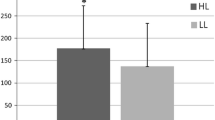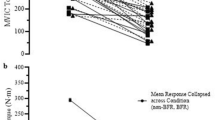Abstract
Purpose
The purpose of this study was to investigate electromyographic amplitude (EMG AMP), EMG mean power frequency (MPF), exercise volume (VOL), total work and muscle activation (iEMG), and time under concentric load (TUCL) during, and muscle cross-sectional area (mCSA) before and after 3 sets to failure at 80 vs. 30 % 1RM resistance exercise.
Methods
Nine men (mean ± SD, age 21.0 ± 2.4 years, resistance training week−1 6.0 ± 3.7 h) and 9 women (age 22.8 ± 3.8 years, resistance training week−1 3.4 ± 3.5 h) completed 1RM testing, followed by 2 experimental sessions during which they completed 3 sets to failure of leg extension exercise at 80 or 30 % 1RM. EMG signals were collected to quantify EMG AMP and MPF during the initial, middle, and last repetition of each set. Ultrasound was used to assess mCSA pre- and post-exercise, and VOL, total work, iEMG, and TUCL were calculated.
Results
EMG AMP remained greater at 80 % than 30 % 1RM across all reps and sets, despite increasing 74 and 147 % across reps at 80 and 30 % 1RM, respectively. EMG MPF decreased across reps at 80 and 30 % 1RM, but decreased more and was lower for the last reps at 30 than 80 % 1RM (71.6 vs. 78.1 % MVIC). mCSA increased more from pre- to post-exercise for 30 % (20.2–24.1 cm2) than 80 % 1RM (20.3–22.8 cm2). VOL, total work, iEMG and TUCL were greater for 30 % than 80 % 1RM.
Conclusion
Muscle activation was greater at 80 % 1RM. However, differences in volume, metabolic byproduct accumulation, and muscle swelling may help explain the unexpected adaptations in hypertrophy vs. strength observed in previous studies.







Similar content being viewed by others
Abbreviations
- 1RM:
-
One repetition maximum
- ANOVA:
-
Analysis of variance
- EI:
-
Echo intensity
- EMG AMP:
-
Electromyographic amplitude
- EMG MPF:
-
Electromyographic mean power frequency
- iEMG:
-
Total integrated electromyographic amplitude
- mCSA:
-
Muscle cross-sectional area
- MVIC:
-
Maximal voluntary isometric contraction
- RF:
-
Rectus femoris
- TUCL:
-
Time under concentric load
- US:
-
Ultrasound
- VL:
-
Vastus lateralis
- VM:
-
Vastus medialis
- VOL:
-
Volume
References
Ahtiainen JP, Hoffren M, Hulmi JJ, Pietikainen M, Mero AA, Avela J, Hakkinen K (2010) Panoramic ultrasonography is a valid method to measure changes in skeletal muscle cross-sectional area. Eur J Appl Physiol 108:273–279. doi:10.1007/s00421-009-1211-6
Akima H, Saito A (2013) Activation of quadriceps femoris including vastus intermedius during fatiguing dynamic knee extensions. Eur J Appl Physiol 113:2829–2840. doi:10.1007/s00421-013-2721-9
Basmajian JV, De Luca CJ (1985) Muscles alive : their functions revealed by electromyography, 5th edn. Williams & Wilkins, Baltimore
Beck TW, Housh TJ (2008) Use of electromyography in studying human movement. In: Hong Y, Bartlett R (eds) Routledge handbook of biomechanics and human movement. Routledge, New York, pp 214–230
Brody LR, Pollock MT, Roy SH, De Luca CJ, Celli B (1991) pH-induced effects on median frequency and conduction velocity of the myoelectric signal. J Appl Physiol (1985) 71:1878–1885
Burd NA et al (2010a) Resistance exercise volume affects myofibrillar protein synthesis and anabolic signalling molecule phosphorylation in young men. J Physiol 588:3119–3130. doi:10.1113/jphysiol.2010.192856
Burd NA et al (2010b) Low-load high volume resistance exercise stimulates muscle protein synthesis more than high-load low volume resistance exercise in young men. PLoS ONE 5:e12033. doi:10.1371/journal.pone.0012033
Burd NA et al (2012a) Muscle time under tension during resistance exercise stimulates differential muscle protein sub-fractional synthetic responses in men. J Physiol 590:351–362. doi:10.1113/jphysiol.2011.221200
Burd NA, Mitchell CJ, Churchward-Venne TA, Phillips SM (2012b) Bigger weights may not beget bigger muscles: evidence from acute muscle protein synthetic responses after resistance exercise. Appl Physiol Nutr Metab 37:551–554. doi:10.1139/h2012-022
Burd NA, Moore DR, Mitchell CJ, Phillips SM (2013) Big claims for big weights but with little evidence. Eur J Appl Physiol 113:267–268. doi:10.1007/s00421-012-2527-1
Carpinelli RN (2008) The size principle and a critical analysis of the unsubstantiated heavier-is-better recommendation for resistance training. J Exerc Sci Fitness 6:67–86
Conwit RA, Stashuk D, Suzuki H, Lynch N, Schrager M, Metter EJ (2000) Fatigue effects on motor unit activity during submaximal contractions. Arch Phys Med Rehabil 81:1211–1216. doi:10.1053/apmr.2000.6975
Cook SB, Murphy BG, Labarbera KE (2013) Neuromuscular function after a bout of low-load blood flow-restricted exercise. Med Sci Sports Exerc 45:67–74. doi:10.1249/MSS.0b013e31826c6fa8
Diemont B, Figini MM, Orizio C, Perini R, Veicsteinas A (1988) Spectral analysis of muscular sound at low and high contraction level. Int J Biomed Comput 23:161–175
Fry CS et al (2010) Blood flow restriction exercise stimulates mTORC1 signaling and muscle protein synthesis in older men. J Appl Physiol (1985) 108:1199–1209. doi:10.1152/japplphysiol.01266.2009
Fukunaga T, Ichinose Y, Ito M, Kawakami Y, Fukashiro S (1997) Determination of fascicle length and pennation in a contracting human muscle in vivo. J Appl Physiol (1985) 82:354–358
Fumarola C, La Monica S, Guidotti GG (2005) Amino acid signaling through the mammalian target of rapamycin (mTOR) pathway: role of glutamine and of cell shrinkage. J Cell Physiol 204:155–165. doi:10.1002/jcp.20272
Garber CE et al (2011) American College of Sports Medicine position stand. Quantity and quality of exercise for developing and maintaining cardiorespiratory, musculoskeletal, and neuromotor fitness in apparently healthy adults: guidance for prescribing exercise. Med Sci Sports Exerc 43:1334–1359. doi:10.1249/MSS.0b013e318213fefb
Haussinger D, Hallbrucker C, vom Dahl S, Lang F, Gerok W (1990) Cell swelling inhibits proteolysis in perfused rat liver. Biochem J 272:239–242
Henneman E, Somjen G, Carpenter DO (1965) Functional significance of cell size in spinal motoneurons. J Neurophysiol 28:560–580
Herda TJ, Housh TJ, Fry AC, Weir JP, Schilling BK, Ryan ED, Cramer JT (2010) A noninvasive, log-transform method for fiber type discrimination using mechanomyography. J Electromyogr Kinesiol 20:787–794. doi:10.1016/j.jelekin.2010.01.004
Hermens HJ, Bruggen TA, Baten CT, Rutten WL, Boom HB (1992) The median frequency of the surface EMG power spectrum in relation to motor unit firing and action potential properties. J Electromyogr Kinesiol 2:15–25. doi:10.1016/1050-6411(92)90004-3
Hermens HJ et al (1999) SENIAM 8: European recommendations for surface electromyography. Roessngh Research and Development, The Netherlands
Hoffmann EK, Lambert IH, Pedersen SF (2009) Physiology of cell volume regulation in vertebrates. Physiol Rev 89:193–277. doi:10.1152/physrev.00037.2007
Jenkins ND et al (2015) Test–retest reliability of single transverse versus panoramic ultrasound imaging for muscle size and echo intensity of the biceps brachii. Ultrasound Med Biol. doi:10.1016/j.ultrasmedbio.2015.01.017
Korhonen MT et al (2009) Biomechanical and skeletal muscle determinants of maximum running speed with aging. Med Sci Sports Exerc 41:844–856. doi:10.1249/MSS.0b013e3181998366
Kwatny E, Thomas DH, Kwatny HG (1970) An application of signal processing techniques to the study of myoelectric signals. IEEE Trans Biomed Eng 17:303–313
Loenneke JP, Fahs CA, Wilson JM, Bemben MG (2011) Blood flow restriction: the metabolite/volume threshold theory. Med Hypotheses 77:748–752. doi:10.1016/j.mehy.2011.07.029
Low SY, Rennie MJ, Taylor PM (1997) Signaling elements involved in amino acid transport responses to altered muscle cell volume. FASEB J 11:1111–1117
Marsden CD, Meadows JC, Merton PA (1983) “Muscular wisdom” that minimizes fatigue during prolonged effort in man: peak rates of motoneuron discharge and slowing of discharge during fatigue. Adv Neurol 39:169–211
Mitchell CJ, Churchward-Venne TA, West DW, Burd NA, Breen L, Baker SK, Phillips SM (2012) Resistance exercise load does not determine training-mediated hypertrophic gains in young men. J Appl Physiol (1985) 113:71–77. doi:10.1152/japplphysiol.00307.2012
Netreba A et al (2013) Responses of knee extensor muscles to leg press training of various types in human. Ross Fiziol Zh Im I M Sechenova 99:406–416
NSCA (2008) Essentials of strength training and conditioning, 3rd edn. Human Kinetics, Champaign
Ogasawara R, Loenneke JP, Thiebaud RS, Abe T (2013) Low-load bench press training to fatigue results in muscle hypertrophy similar to high-load bench press training. Int J Clin Med 4:114–121
Popov DV et al (2006) Hormonal adaptation determines the increase in muscle mass and strength during low-intensity strength training without relaxation. Fiziol Cheloveka 32:121–127
Popov DV et al (2015) Influence of resistance exercise intensity and metabolic stress on anabolic signaling and expression of myogenic genes in skeletal muscle. Muscle Nerve 51:432–442. doi:10.1002/mus.24314
Schoenfeld BJ (2010) The mechanisms of muscle hypertrophy and their application to resistance training. J Strength Cond Res 24:2857–2872. doi:10.1519/JSC.0b013e3181e840f3
Schoenfeld BJ, Contreras B, Willardson JM, Fontana F, Tiryaki-Sonmez G (2014) Muscle activation during low- versus high-load resistance training in well-trained men. Eur J Appl Physiol 114:2491–2497. doi:10.1007/s00421-014-2976-9
Schoenfeld BJ, Peterson MD, Ogborn D, Contreras B, Sonmez GT (2015) Effects of low- versus high-load resistance training on muscle strength and hypertrophy in well-trained men. J Strength Cond Res. doi:10.1519/JSC.0000000000000958
Schuenke MD, Herman J, Staron RS (2013) Preponderance of evidence proves “big” weights optimize hypertrophic and strength adaptations. Eur J Appl Physiol 113:269–271. doi:10.1007/s00421-012-2528-0
Shrout PE, Fleiss JL (1979) Intraclass correlations: uses in assessing rater reliability. Psychol Bull 86:420–428
Sjogaard G, Adams RP, Saltin B (1985) Water and ion shifts in skeletal muscle of humans with intense dynamic knee extension. Am J Physiol 248:R190–R196
Staron RS, Malicky ES, Leonardi MJ, Falkel JE, Hagerman FC, Dudley GA (1990) Muscle hypertrophy and fast fiber type conversions in heavy resistance-trained women. Eur J Appl Physiol Occup Physiol 60:71–79
Takarada Y, Tsuruta T, Ishii N (2004) Cooperative effects of exercise and occlusive stimuli on muscular function in low-intensity resistance exercise with moderate vascular occlusion. Jpn J Physiol 54:585–592
Terzis G, Spengos K, Mascher H, Georgiadis G, Manta P, Blomstrand E (2010) The degree of p70 S6k and S6 phosphorylation in human skeletal muscle in response to resistance exercise depends on the training volume. Eur J Appl Physiol 110:835–843. doi:10.1007/s00421-010-1527-2
Acknowledgments
The authors would like to thank Noelle M. Yeo and Jessie M. Miller for their help with data collection. This study was supported in part by the University of Nebraska Agricultural Research Division with funds provided through the Hatch Act (Agency: United States Department of Agriculture, National Institute of Food and Agriculture; Accession No.: 1000080; Project No.: NEB-36-078).
Author information
Authors and Affiliations
Corresponding author
Ethics declarations
The authors have no perceived conflicts of interest to declare.
Additional information
Communicated by Nicolas Place.
Rights and permissions
About this article
Cite this article
Jenkins, N.D.M., Housh, T.J., Bergstrom, H.C. et al. Muscle activation during three sets to failure at 80 vs. 30 % 1RM resistance exercise. Eur J Appl Physiol 115, 2335–2347 (2015). https://doi.org/10.1007/s00421-015-3214-9
Received:
Accepted:
Published:
Issue Date:
DOI: https://doi.org/10.1007/s00421-015-3214-9




